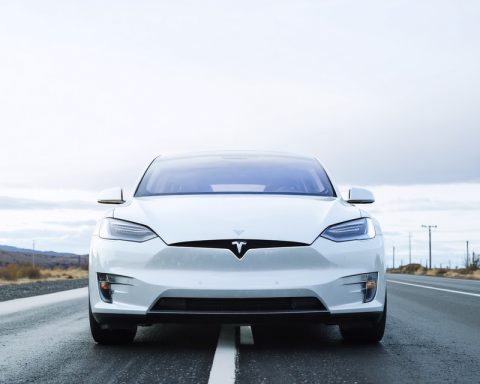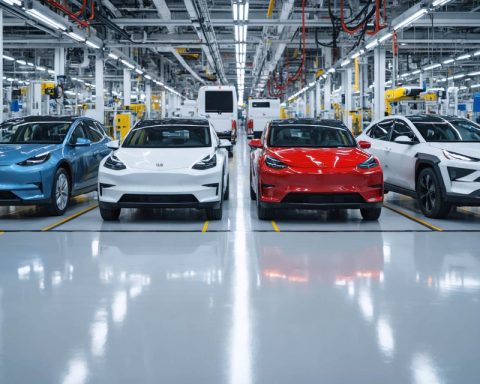- In Europe, Tesla faces significant challenges with declining sales despite a growing electric vehicle market.
- Key markets experiencing sales drops include the Netherlands (-61%), Sweden (-64%), Austria (-34%), and France (-37%).
- Contrastingly, sales in Italy (+51%) and Ireland (+40%) show positive growth, albeit inconsistently.
- Global competition intensifies, particularly in China, prompting Tesla to offer zero interest loans.
- Norway, a crucial indicator of Tesla’s European impact, shows mixed results with Model Y sales still below last year.
- Social and political disruptions in North America affect Tesla’s brand perception.
- Success in the electric vehicle market requires not just technology but strong leadership and an authentic brand narrative.
The electric skies over Europe are roiling, and for Tesla, the turbulence is all too real. Despite the continent’s accelerating embrace of electric vehicles, the once-unchallenged titan finds itself battling unexpected headwinds. As Norwegian fjords glisten with the gleam of new electric models from competitors, Tesla’s grip seems to be slipping.
In the heart of Dutch tulip fields, Tesla’s signature speed is flagging. March saw a staggering 61% dip in sales compared to last year. Similarly, Swedish streets are seeing fewer Model Ys and more of the competition, with Tesla’s sales diving by 64%. Despite Europe’s seemingly inexhaustible appetite for electric cars, the Tesla trajectory is erratic: at times nosediving, then rebounding like an unpredictable rollercoaster.
Amidst the Tyrolean Alps, Austrian consumers are showing a marked coolness towards the brand; figures dropped by 34% in March alone. In France, where Tesla once seduced buyers with sleek designs and promises of a cleaner future, sales were down 37% for March. There’s intrigue as well; Italy’s Tesla sales have recently bounced higher by 51% after a rocky start to the year, highlighting a struggle to maintain momentum against a backdrop of renewed interest.
Yet not all is bleak. Ireland offers a sliver of gold at the end of Tesla’s European rainbow. Here, the Model 3 captures hearts anew, with sales jumping over 40%, even as the Model Y stumbles. It’s a nuanced dance of numbers, a delicate waltz between gains and losses. While analysts deliberate and investors nervously clutch their shares, Elon Musk and Tesla are finding that politics, production pauses, and market perceptions now dictate the tempo.
Tesla’s challenges extend beyond European borders. China, a critical market, presents fierce competition as local EV makers race ahead. A strategic counter, Tesla offers zero interest loans hoping to stir interest in the freshly revamped Model Y.
Norway, a veritable barometer for electric success, shows an eerie calm. Despite a rebound in Model Y sales, figures remain 9% shy compared to last year. The Model 3, often overshadowed, finds itself climbing back, yet the European market remains a conundrum wrapped in an electric enigma.
Acts of dissent ripple through North America too, where protests and unfortunate acts of vandalism target Tesla as a potent symbol of political discourse, rather than a beacon of innovation.
Navigating these economic and social squalls, Tesla must adapt or risk being overrun by rival electric waves. In the coming weeks, as first-quarter figures roll in, a sharper picture will emerge. But one thing is clear: Tesla must harness more than just battery power to reignite its European drive—perhaps it’s the power of perception that will ultimately steer its course through these turbulent times.
In this electrified age, the takeaway is palpable: Tesla’s journey underscores that in an increasingly connected world, market viability demands more than just cutting-edge technology; it requires deft leadership, cultural agility, and a brand narrative charged with authenticity and responsiveness. As the electric vehicle revolution continues to evolve, Tesla’s next moves will be crucial.
Tesla’s Bumpy Ride in Europe: Can Innovation and Strategy Save the Day?
Tesla’s journey in Europe, once marked by impressive dominance, is now facing a wave of challenges as the electric vehicle (EV) market rapidly expands. With competitors surging ahead and market dynamics shifting, it’s essential to delve into additional aspects of Tesla’s situation and understand the broader implications for the EV industry.
How Tesla Can Navigate Europe’s Electrified Landscape
1. Adapting to Local Preferences: To strengthen its foothold, Tesla could focus on tailoring models and services to European preferences. This might include integrating more European designs and features, such as right-hand drive options for countries like the UK and Ireland, or enhancing in-car technologies specific to European standards.
2. Enhancing Customer Experience: Tesla could bolster its customer service network across Europe, providing more readily available support and maintenance services. Creating a robust network of service centers could alleviate customer concerns regarding repairs and parts availability.
3. Competitive Pricing Strategies: With competitors launching models at competitive price points, Tesla might consider revisiting its pricing strategy in Europe. Offering flexible pricing, special discounts, or extended financing options could make Tesla’s vehicles more appealing to a broader audience.
Industry Trends and Market Forecasts
– Growing Competition: Companies like Volkswagen, BMW, and Renault are continuously innovating and expanding their electric portfolios, putting pressure on Tesla to maintain its status as a tech leader.
– Government Policies: European countries are increasingly tightening their emissions regulations, accelerating the shift towards EVs. Tesla could leverage its eco-friendly benefits to align with governmental initiatives and earn favorable tax treatments or subsidies.
– Infrastructure Expansion: Many European countries are investing heavily in EV infrastructure, such as charging networks, which could play in Tesla’s favor. Collaborating with governments and private entities to expand Tesla’s Supercharger network is crucial.
The European Consumer Perspective
– Real-World Use Cases: European customers might prioritize features such as compact size for urban driving, efficient energy usage due to high fuel prices, and strong performance in varied terrains and weather conditions.
Insights and Predictions
– Mature Market Dynamics: Tesla’s brand perception as innovative and eco-friendly might not suffice in mature markets like Norway and the Netherlands, where consumers now prioritize value and feature diversity.
– Potential Growth Areas: Emerging European markets, such as Eastern Europe, where EV adoption is growing, could present opportunities for Tesla with entry-level models.
Controversies and Limitations
– Market Perceptions: Public perception challenges driven by political and social forces can heavily impact sales. Tesla might need to engage in proactive public relations campaigns to reshape narratives.
– Supply Chain Issues: Global supply chain disruptions, impacting semiconductor availability and battery production, could hinder Tesla’s ability to meet demand.
Actionable Recommendations
– Increase R&D Investment in Europe: Local R&D centers could help tailor products more closely to European consumer preferences and overcome regulatory hurdles.
– Collaborate with Local Firms: Form partnerships with European technology firms to foster innovation and integrate localized solutions.
– Expand Gigafactory Capacity: Consider investing in additional manufacturing capabilities within Europe to reduce costs and improve supply chain efficiency.
For those interested in staying updated on EV trends and Tesla’s strategies, visiting Tesla can provide the latest official insights and company announcements.
As Tesla navigates this electrified age, the company’s actions will likely set important precedents across the EV industry. The brand’s resilience and ability to adapt to these dynamic changes will determine its future trajectory in the global market.














